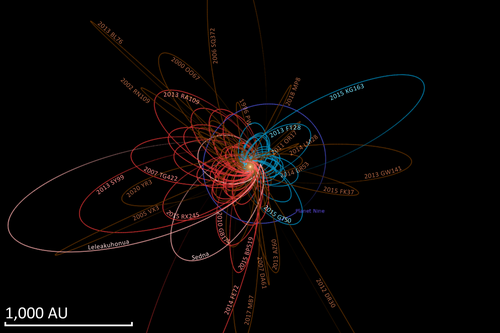astro.wikisort.org - Asteroid
(87269) 2000 OO67 (prov. designation: 2000 OO67) is a trans-Neptunian object, approximately 64 kilometers (40 miles) in diameter, on a highly eccentric orbit in the outermost region of the Solar System. It was discovered by astronomers at the Chilean Cerro Tololo Inter-American Observatory on 29 July 2000.
| Discovery | |
|---|---|
| Discovered by | Cerro Tololo Obs. |
| Discovery site | Cerro Tololo Obs. |
| Discovery date | 29 July 2000 |
| Designations | |
Alternative designations | 2000 OO67 |
Minor planet category | TNO[1] · centaur (DES)[2] |
| Orbital characteristics[1] | |
| Epoch 13 January 2016 (JD 2457400.5) | |
| Uncertainty parameter 2 | |
| Observation arc | 2187 days (5.99 yr) |
| Earliest precovery date | 29 July 2000 |
| Aphelion | 1,041.743 AU (155.8425 Tm) |
| Perihelion | 20.7305754 AU (3.10124994 Tm) |
Semi-major axis | 531.2369251 AU (79.47191283 Tm) |
| Eccentricity | 0.9609768 |
Orbital period (sidereal) | 11760.29 yr (4295446.2 d) |
Average orbital speed | 0.88 km/s |
Mean anomaly | 0.328967° |
Mean motion | 0° 0m 0.302s / day |
| Inclination | 20.0729° |
Longitude of ascending node | 142.391° |
Argument of perihelion | 212.345° |
| Uranus MOID | 1.82 AU (0.272 Tm)[3] |
| TJupiter | 5.265 |
| Physical characteristics | |
Mean diameter | 64 km (est. at 0.09)[4] |
| Temperature | ~12 K |
Absolute magnitude (H) | 9.2[1] |
Description
At aphelion it is over 1,000 AU from the Sun and, with a perihelion of 21 AU, almost crosses the orbit of Uranus at closest approach. Astronomers with the Deep Ecliptic Survey classify it as a centaur rather than a trans-Neptunian object.[2][5] 2000 OO67 came to perihelion in April 2005.[2][1][6] Both 2000 OO67 and 2006 SQ372 are calculated to take longer than Sedna to orbit the Sun using either heliocentric coordinates or barycentric coordinates.
Comparison

See also
- 2002 RN109
- 2005 VX3
- (308933) 2006 SQ372
- 2007 TG422
- TAU (spacecraft) (probe designed to go 1000 AU in 50 years)
- List of Solar System objects by greatest aphelion
References
- "JPL Small-Body Database Browser: 87269 (2000 OO67)" (2006-07-25 last obs). Retrieved 12 April 2016.
- Marc W. Buie. "Orbit Fit and Astrometric record for 87269" (2006-07-25 using 33 of 34 obs). Deep Ecliptic Survey. Retrieved 2008-05-18.
- "(87269) = 2000 OO67". IAU minor planet center. Archived from the original on 2013-06-26. Retrieved 2017-02-22.
- "Asteroid Size Estimator". CNEOS NASA/JPL. Retrieved 3 March 2020.
- Structure and Dynamics of the Centaur Population: Constraints on the Origin of Short-Period Comets
- Yeomans, Donald K. "Horizons Online Ephemeris System". California Institute of Technology, Jet Propulsion Laboratory. Retrieved 2008-01-25.
External links
- List Of Centaurs and Scattered-Disk Objects at the Minor Planet Center
- (87269) 2000 OO67 at AstDyS-2, Asteroids—Dynamic Site
- (87269) 2000 OO67 at the JPL Small-Body Database
На других языках
[de] (87269) 2000 OO67
(87269) 2000 OO67 ist ein transneptunisches Objekt, das am 29. Juli 2000 am Cerro Tololo Inter-American Observatory entdeckt wurde. Bemerkenswert ist seine außerordentlich exzentrische Bahn. 2000 OO67 nähert sich der Sonne bis auf etwa 21 Astronomische Einheiten (AE), erreicht im sonnenfernsten Punkt aber einen Abstand von mehr als 1100 AE (ca. 0,02 Lichtjahre). Die Umlaufzeit beträgt über 10.000 Jahre.- [en] (87269) 2000 OO67
[ru] (87269) 2000 OO67
(87269) 2000 OO67 — небольшой транснептуновый объект. Был открыт в Серро-Тололо 29 июля 2000 года. Относится к объектам рассеянного диска.Другой контент может иметь иную лицензию. Перед использованием материалов сайта WikiSort.org внимательно изучите правила лицензирования конкретных элементов наполнения сайта.
WikiSort.org - проект по пересортировке и дополнению контента Википедии